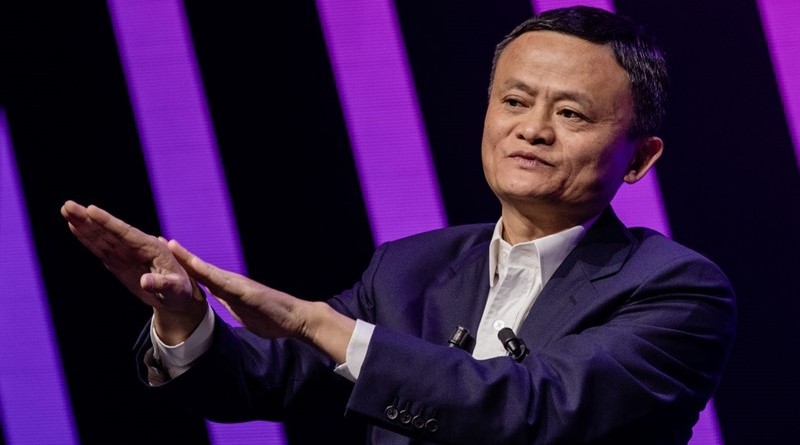Jack Ma steps down as Chairman of Alibaba while Daniel Zhang steps in
2019 is a big year for Alibaba. The Chinese e-commerce giant is celebrating its twentieth anniversary and its high-profile founder Jack Ma, is stepping down as chairman on Tuesday.
Since its founding in 1999, Alibaba has gone from being a traditional e-commerce company to a conglomerate that has businesses from logistics to food delivery and cloud computing. It is now a company valued over $460 billion.
Here are some of key moments in Alibaba’s history.
April 1999: The journey begins
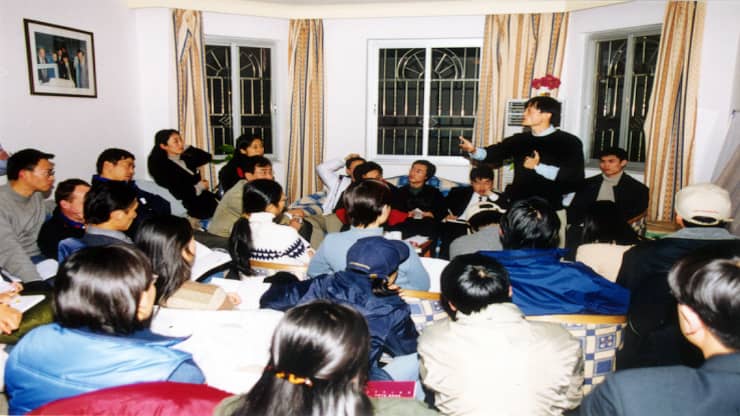
Alibaba founder Jack Ma holds a meeting in his apartment in 1999, the year the Chinese e-commerce giant was established.Alibaba
Alibaba was established by a group of 18 founders led byJack Ma. The group worked out of Ma’s apartment in the Chinese city of Hangzhou, where Alibaba is now headquartered.
Its first website was Alibaba.com, an English-language wholesale marketplace. That same year, Alibaba launched a domestic wholesale market place.
January 2000: SoftBank invests
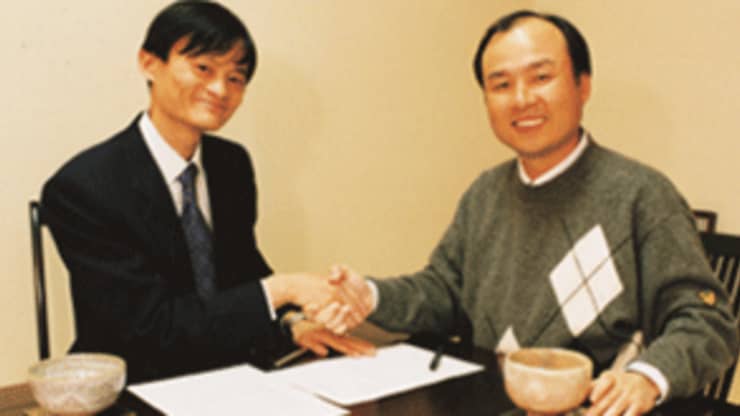
Alibaba founder Jack Ma and SoftBank’s Masayoshi Son shake hands after the Japanese conglomerate led a $20 million funding round into the company in January 2000.Alibaba
Alibaba got a $20 million investment from a group of investors led by SoftBank.
“We didn’t talk about revenues, we didn’t even talk about a business model,” said Ma about SoftBank CEO Masayoshi Son, according to a report by the Wall Street Journal at the time. “We just talked about a shared vision. Both of us make quick decisions.”
That investment helped Alibaba to grow.
May 2003: Taobao is born
Taobao is an online shopping platformin China run by Alibaba, where third-party sellers can push their products.
In Alibaba’s 2015 fiscal year, Taobao’s gross merchandise volume reached1.59 trillion yuan ($223.9 billion). That has grown to 3.11 trillion yuan in the 2019 fiscal year.
Revenue from Taobao is a crucial part of Alibaba’s core commerce business.
December 2004: Alipay launch
Alipay is one of China’s two big payments platforms, along with rival WeChat Pay which is owned by Tencent. It’s a system based on QR codes, a kind of bar code, that’s found at merchants’ payment counters. Buyers in stores can scan the code to make payments. But Alipay can also be used in online stores.
However, Alipay has proved to be a controversial asset throughout Alibaba’s history, causing the company and its founder Ma, to clash with key shareholders Yahoo and SoftBank.
August 2005: Yahoo becomes biggest shareholder
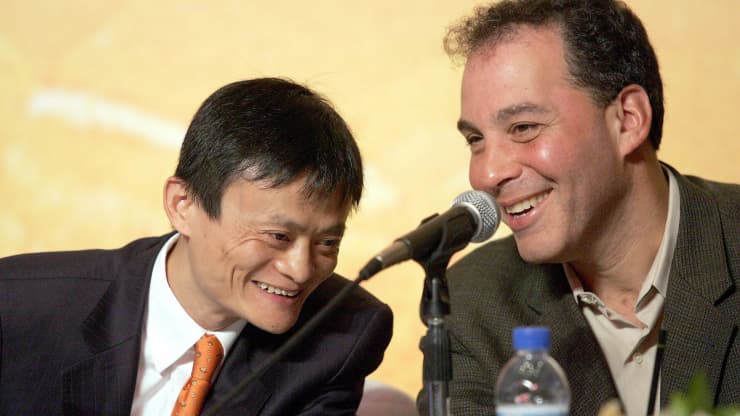
Alibaba.com founder Jack Ma (L) and Yahoo’s chief operating officer at the time Daniel Rosensweig during a joint press conference to announce their deal in Beijing, 11 August 2005. Yahoo Inc signed a deal to buy 40 percent of Alibaba.com for $1 billion cash while handing over the running of its China operations to the Chinese online retailer.AFP | Getty Images
Yahoo poured $1 billion into Alibaba for a 40% stake in the company, making it the e-commerce firm’s largest shareholder.
As part of the deal, Alibaba took control of Yahoo’s China business.
“Together, we will create one of the largest Internet companies in China, and our combined assets will make us the only company that has a leading position in all the key sectors that are driving explosive Internet growth in China such as search, commerce and communications,” Terry Semel, Yahoo’s CEO at the time said in a press release.
November 2007: Hong Kong IPO
Before Alibaba’s debut in the U.S. in 2014, it carried out an initial public offering (IPO) in Hong Kong in 2007.
The public listing raised $13.1 billion Hong Kong dollars in gross proceeds. On its opening day, Alibaba shares surged from the offer price of $13.50 Hong Kong dollars to as high as $39.50 Hong Kong dollars.
April 2008: The birth of Tmall
Alibaba launched a product called Taobao Mall which was spun off years later and became Tmall. Along with Taobao, Tmall is now one of Alibaba’s most important e-commerce properties in terms of revenue.
Tmall has positioned itself as a place where foreign brands can set up an online store and sell to Chinese consumers.
Luxury fashion brands, electronics makers and even Starbucks are on Tmall.
September 2009: Cloud business launched
Alibaba launched its cloud business in 2009 and it is now one of the biggest in China.
Cloud computing is the second-largest revenue source for the company, and its fastest-growing businesses.
Alibaba CEO Daniel Zhang told CNBC last year that cloud will be the firm’s “main business” in the future.
“Cloud computing is our long-term strategy. We strongly believe that every business in the future will be powered by cloud,” he said.
November 2009: Singles Day extravaganza
Singles Day — also known as the Double 11 festival — is China’s largest shopping event of the year. It was pioneered by current Alibaba CEO Zhang.
Retailers offer huge discounts on that day, and it’s turned into a multibillion dollar festival.
Alibaba saw gross merchandising value — the value of goods sold via its platforms — hit $7.8 million in the 2009 edition of Singles Day. That figure stood at $30.8 billion for the 2018 event, according to the exchange rate at the time.
“I never expected that we could actually transform this day into a commercial day … for the whole society,” Zhang told CNBC in an interview last year.
May 2011: Alipay controversy
Alibaba sold control of Alipay to a group controlled by Jack Ma. At the time, the company said it was because of new rules issued by the country’s central bank — the People’s Bank of China. The regulations for third-party online payment required them to get specific licenses.
However Yahoo, Alibaba’s biggest shareholder at the time, said the sale of Alipay happened without its knowledge, a statement that the Chinese e-commerce giant denied.
The episode raised concerns about Alibaba’s governance structure.
Yahoo, SoftBank and Alibaba eventually came to a deal that same year: Alibaba would be paid at least $2 billion but no more than $6 billion if Alipay went public; Alipay was also required to pay licensing fees and continue serving Taobao.
June 2012: Hong Kong delisting
Just five years after its debut on the Hong Kong stock exchange, Alibaba took the company private through a de-listing.
The company paid $2.45 billion to buy the 27% of Alibaba.com held by the public. This equated to $13.50 Hong Kong dollars a share, the same offering price for the IPO back in 2007.
“Taking Alibaba.com private will allow our company to make long-term decisions that are in the best interest of our customers and that are also free from the pressures that come from having a publicly listed company,” Ma said in comments at the time.
September 2012: Alibaba’s Yahoo buyback
Alibaba bought back half of Yahoo’s 40% stake for $7.6 billion. Yahoo received approximately $6.3 billion in cash and $800 million in preference shares in Alibaba.
This was a big return for Yahoo after its initial $1 billion investment in 2005.
September 2014: New York IPO
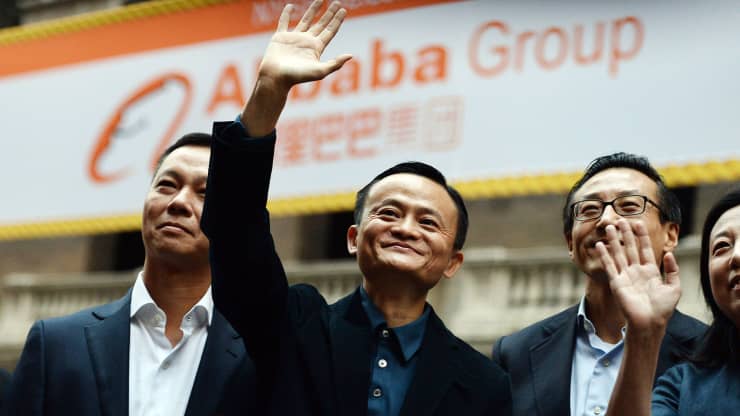
Chinese online retail giant Alibaba CEO Jack Ma (C) waves as he arrives at the New York Stock Exchange in New York on September 19, 2014.Jewel Samad | AFP | Getty Images
Alibaba went public on the New York Stock exchange in what was the biggest IPO in history.
The e-commerce giant raised around $25 billion in its New York IPO. It’s now one of Asia’s largest technology firms by valuation.
Alibaba’s stock is up over 150% from its $68 per share listing price.
October 2014: Ant Financial is created
After the controversial spin-off of Alipay, Ant Financial was created to encompass not just the payment system but other financial services.
The creation of this affiliate company signaled Alibaba’s intentions to push into financial technology or fintech.
Ant Financial,now China’s largest fintech firm, is reportedly valued at around $150 billion.
August 2015: $4.6 billion Suning deal
Alibaba invested 28.3 billion yuan, which was around $4.56 billion, into Chinese bricks-and-mortar electronics retailer Suning. This followed an investment the year before into department store chain, Intime.
It signaled Alibaba’s intent to push on with its so-called “new retail” strategy where it looks to merge its online business with offline stores. The aim is to bring together payments, e-commerce, food delivery and other parts of its business into one big ecosystem.
It’s a strategy that the company continues to push on with today.
April 2016: International push
Since it’s founding 20 years ago, Alibaba’s focus has very much been on its domestic market: helping foreign and local brands sell to Chinese consumers.
But in April 2016, the company took a controlling stake in Singapore-based Lazada, an e-commerce company that serves several markets in Southeast Asia.
That marked Alibaba’s first major international push in the e-commerce space.
February 2018: Alibaba buys Ant stake
Alibaba bought a 33% stake in Ant Financial. It was able to do so because of a clause in a contract between the two companies from 2014 when Ant was created.
There have been reports that Ant Financial is gearing up for an IPO, though the company has not made any official announcements.
September 2019: Jack Ma steps down as chairman
In September 2018, Alibaba said Jack Ma will step down as chairman of the board one year later — on September 10, 2019.
Current CEO Zhang takes Ma’s place as chairman.
Ma intends to stay on the Alibaba board of directors until the 2020 annual shareholders meeting.
STORY FROM CNBC

